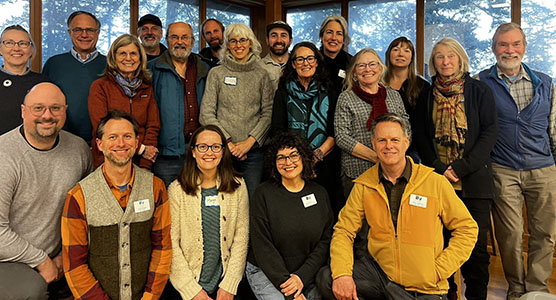School Board Debates Options for Raising Match Funds
Orcas Island School District (OISD) Superintendent Barbara Kline announced to the school board last week that the district has been awarded a grant of $460,000 from the Office of the Superintendent of Public Instruction (OSPI) to repair and replace the heating-ventilation-air conditioning (hvac) and plumbing systems in the elementary school.
Kline also said, “The grant requires a three-to-one match for a total expenditure of about 1.7 million in order to complete the required work. If we cannot find the matching dollars, we will need to return the funding to OSPI.”
Kline credited OISD Administrative Assistant Cathy Ferran for spearheading the grant request, which included an energy audit conducted by engineers from University Mechanical who contracted with the OISD last year. The audit of Orcas school facilities was required in the grant process to identify projects that could demonstrate guaranteed energy savings.
Also required by the grant is that the local community “match” the funds and complete the project by June of 2012.
Twenty-one school districts throughout the state collectively received $7.6 million for energy operational improvements to schools in this round of energy efficiency grants.Superintendent of Public Instruction Randy Dorn said, “This was our most competitive round yet. Because of the high demand, we were only able to fund half of the projects that applied in this round.”
Kline discussed how best to “leverage” the matching funds for this grant and for other school needs at the OISD school board meeting last week. “There are a number of ways in which we could come up with the matching funds,” Kline told the board.
Options include the Qualified Zone Academy (QZA) Bond Program, a capital
levy, grants, donations, bond, and state loans. “The simplest [funds] to obtain are likely to be the QZA bonds and the state loans,” Kline said.
Kline said, “The original thought was that the bond [proposal voted down in February and August this year] would provide the match.” She said that bond funding opportunities allow “some time to raise funds.”
She said that the work planned is quite intrusive, and would be scheduled for the summer of 2011 (the grant requires that the work be completed by 2012).
Keith Whitaker District Business Manager, said that the state “qualified school construction money” currently has $8 million dollars, since previous applicants for that fund did not qualify. Those funds have an application deadline of mid-January 2011.
Those “qualified zone academy ” (QZA) bonds are zero interest; they are available because they pay the investor in tax credits rather than in funds (which makes them not as easy to sell), Whitaker said. One direction suggested by the OISD bond advisor, Cynthia Weed, is to “talk to a local bank that may take bonds to support the local school and make use of the tax credits.”
Whitaker reported that Weed said that the QZA bonds, unlike personal loans, don’t require the applicant school districts to show how they’ll repay, but accept ‘full faith and credit.’
Weed also suggested looking for a local investor “because of the tax-credit returns and the government guarantee: Even at the low interest rate of 2% — combined with the social positive of supporting the school — apparently you can structure a loan at a higher interest rate, say 5%, and the lender can write off the 3% difference as a charitable contribution. “
Later, in board discussion, Chris Sutton called for a vote to go out for a capital levy 0f $6 million in February 2011. The levy would be to make urgent repairs: replace the failed HVAC in the elementary so there is heat; replace the 62 year old original plumbing in the elementary; replace the failed siding on the high school so as to protect it as an asset; and put up braces on the 1980s building to mitigate seismic issues. (The board recognized that the bracing will be effective but not aesthetically appealing.)
Earlier at the School District meeting on Nov. 3o, Superintendent Barbara Kline officially reported that the “condition of [OISD] facilities not in compliance with [regulations] and …. are inadequate for the health and safety of instruction.
“Our facilities are in need of major work to get in compliance with policy.”
Although the board confirmed its commitment to address these health and safety issues ASAP, there was no second for the call for vote, and Sutton’s proposal did not go forward for a vote.
In subsequent discussion, the board had several concerns about going out for a capital levy. Their biggest concern is that it is too soon after the failed bond proposals of 2010. The board would like to spend the next few months conducting the following: public meetings with ardent pro and con parties to the school upgrades. The meetings would have professional and local facilitation.
The board would also like to survey voters to find out several issues:
- how can the OISD best address the building repair needs, knowing that deferral of maintenance worsens the problems
- how to schedule bonds to repair the schools over what period of time, for how much.
In addition, the OISD board expressed the need to better understand what is going on underneath the siding on the high school. If the siding has failed, has there been more effected than the exterior? This question made the request for $6 million in February when there might be more repair needed may seem premature.
In December, the board will consider a variety of non-voted funding scenarios to fix these critical repairs, and to take advantage of the $460,000 grant. The board encourages attendance at their Dec. 23 regular board meeting, and welcomes public comment from those who’ve opposed board decisions in the past, so that they can be addressed.
**If you are reading theOrcasonian for free, thank your fellow islanders. If you would like to support theOrcasonian CLICK HERE to set your modestly-priced, voluntary subscription. Otherwise, no worries; we’re happy to share with you.**







